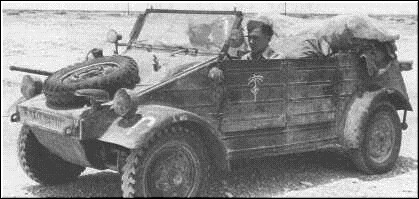Pictures of a Kübelwagen's in use by the Afrikakorps
Rommel was the first General to use the Volkswagen during the military operation in France. He was so impresed by it that he, afterwards, when he was in charge of the Afrika Korps, reordered an ever increasing nunber of these vehicles. The Kübelwagen distinguished itself immediatly by is enormous efficiency on all kind of terrain, in spite of its small horse power (hardly 24 HP) and the drive on the rear-wheels only.
The project dated back to December 1939, when Ferdinand Porsche designed a military version of the Volkswagen (people's car), an automobile, wich he himself had created upon Hitler's personal request for a cheap car wich the average family could efford. In the beginning, the vehicle called Volkswagen 82 "Kübelwagen" was not hailed with enthusiasm. The military staff were rathed sceptical about the rear position of the air-cooled motorand the lack of a 4-wheel drive.
 |
| DAK Kübelwagen in the National War Museum in Canberra - Australia Thanks to Steve Anderson |
By the end of the war, the total output of the factory at wolfburg were 52.000 Volkswagen 82. The vehicle could be armed with a machine gun type MG 34.
 |
| Production of Kübelwagens at the Wolfburg factory |
|
NOTE: Engine 4-cylinder-985 cc VW 23.5 HP at 3000 rpm, production until March 1943. Afterwards 1.131cc engine with 25 HP at 3000 rpm.

 DAK GUNS - Pkw.K1 (type 82) KÜBELWAGEN
DAK GUNS - Pkw.K1 (type 82) KÜBELWAGEN




Very very interesting! Thank you!
ReplyDelete